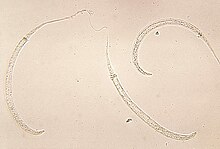Dracunculus medinensis, or Guinea worm, is a nematode that causes dracunculiasis, also known as guinea worm disease.[1] The disease is caused by the female[2] which, at up to 80 centimetres (31 inches) in length,[3] is among the longest nematodes infecting humans.[4] In contrast, the longest recorded male Guinea worm is only 4 cm (1
1⁄2 in).[3]
Guinea worm is on target to be the second infectious disease to be eradicated. It was formerly endemic to a wide swath of Africa and Eurasia; as of 2021, it remains endemic in five countries: Chad, Ethiopia, Mali, South Sudan and Angola, with most cases in Chad and Ethiopia. Guinea worm spread to Angola in ca. 2018, and it is now considered endemic there. Infection of domestic dogs is a serious complication in Chad.
The common name "guinea worm" is derived from the Guinea region of Western Africa.
| Guinea worm | |
|---|---|
 | |
| Scientific classification | |
| Kingdom: | Animalia |
| Phylum: | Nematoda |
| Class: | Secernentea |
| Order: | Camallanida |
| Family: | Dracunculidae |
| Genus: | Dracunculus |
| Species: | D. medinensis |
| Binomial name | |
| Dracunculus medinensis | |
| Synonyms | |
No comments:
Post a Comment